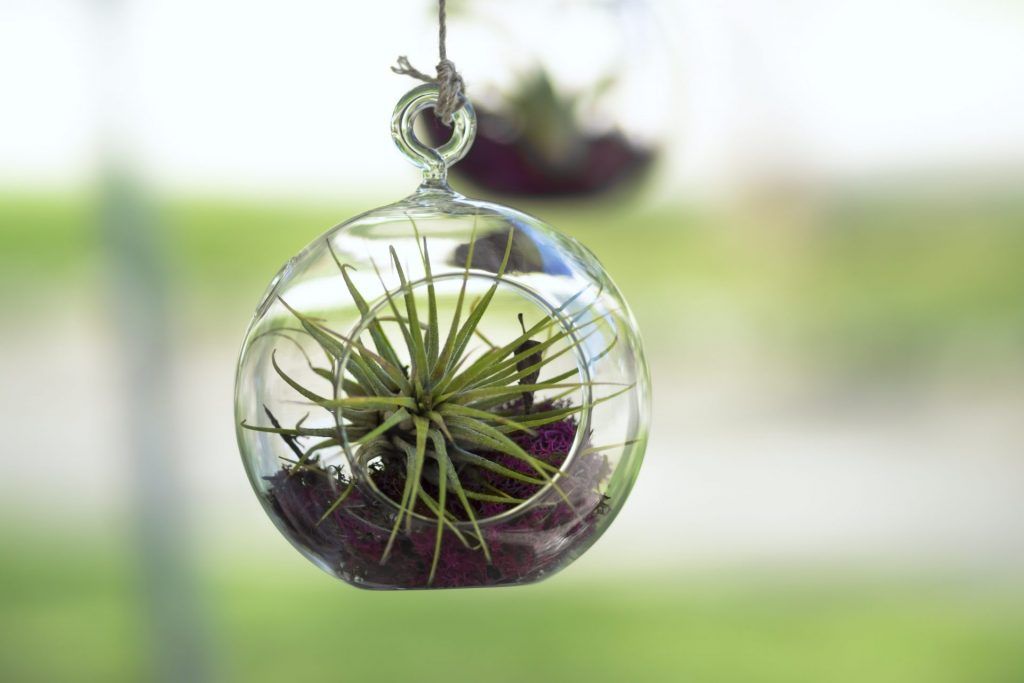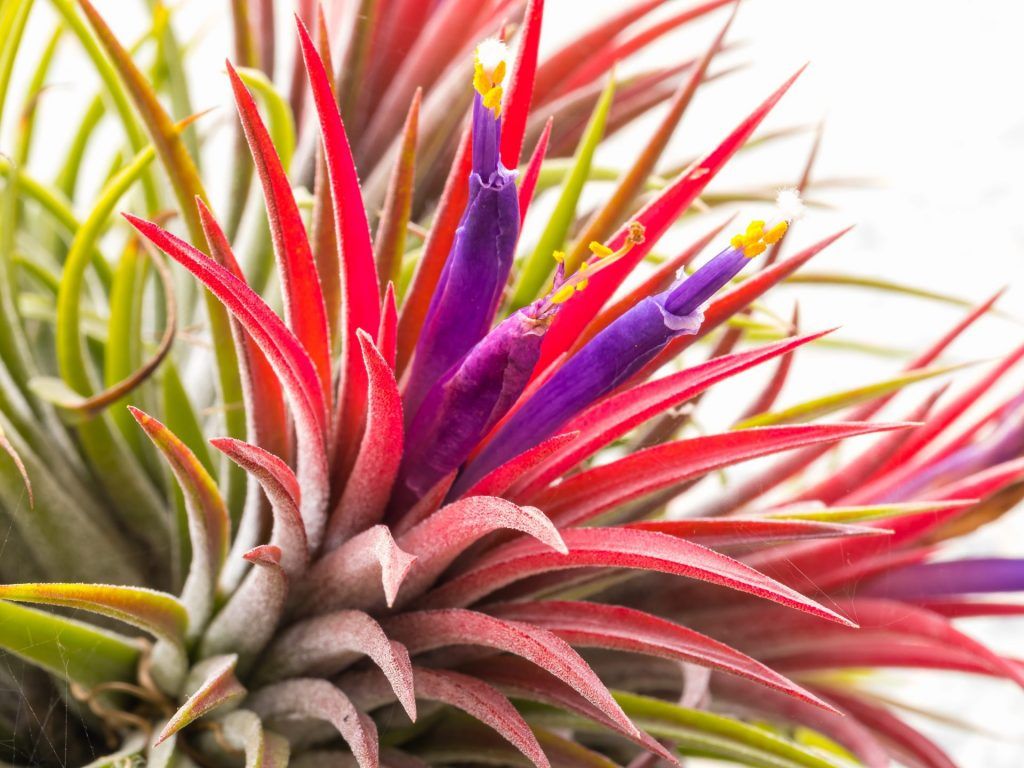By nature, animals are curious and adventurous, most of all cats. Any time I bring something new into the house, my cats will investigate it. Can I play with it? Can I sit in it? Can I eat it? This seems to be the running commentary for my cats’ investigative skills. It makes for some hilarious entertainment at times, to be sure.
But as any responsible pet owner knows, we have to make sure we don’t bring home anything toxic or unsafe. Or, at the very least, keep it away from animals. I don’t think many of us are foregoing chocolate because we have dogs.
So, in this case, what about air plants? Fortunately, air plants are not toxic to cats, dogs, birds, horses, rabbits, or reptiles. Of course, that doesn’t mean cats or other animals won’t get into them and still cause problems, which is what we’re going to take a look at.
What are air plants?
Air plants a beautiful, low-maintenance, houseplant also known as tillandsias. They are popular due to their unique ability to absorb water and nutrients through their leaves, which is where they get the name “air plant.” They also don’t need any soil, which usually means less chance of your pet’s making a mess. In fact, they don’t grow in soil at all, even if you want to try.
Fun Fact: Tillandsias are part of the bromeliad family, just like pineapple plants!
Air plants are one of the best types of plants to keep when you have pets because they are non-toxic to animals. Plus, they come in all sorts of shapes, sizes, and colors. For example, they range in size from 2 inches to 7 feet. So, there is a huge variety when it comes to picking out decorative plants.
Growing
Air plants are easy to care for, even if you don’t have a green thumb. They need bright indirect light and occasional watering (misting). Because they don’t need soil, they can be placed pretty much anywhere, like in a terrarium, hanging from the ceiling, or growing on a piece of wood in the windowsill.

Benefits
Like any other plant, air plants also improve the air quality in your home by filtering pollutants and producing oxygen.
Are air plants toxic to cats?
Fortunately, there are nearly 650 varieties of air plants, and none of them are toxic to cats. So, you can breathe a sigh of relief if your cat is nibbling on the leaves!
Many air plants contain calcium oxalate crystals, which, when eaten in excess, can cause symptoms of poisoning. Unless your cat has pica (compulsive eating disorder), it’s not likely that they will eat enough to cause these issues.
For the most part, your cat poses more of a risk to an air plant than the other way around. An overly curious cat can tear off the leaves, chew it to death, or knock it on the floor.
With that said, there are still a few concerns for the cat.

Photo Credit: Shutterstock
Choking
Some air plants have sharp, pointed leaves, which can damage the inside of a cat’s mouth or create a choking hazard.
Upset Stomach
Non-toxic does not mean edible. If your cat eats air plants, especially in larger quantities, it can upset their stomach. They may experience vomiting, diarrhea, or loss of appetite after eating an air plant.
Moss Allergy
Many times, air plants are grown on moss or around other companion plants, which can trigger allergic reactions in some cats.
Fertilizer Ingestion
If you fertilize your plants, it’s possible your cat ingests some of it. Most fertilizers contain chemicals that are poisonous or harmful to cats. Check the product label for more information about safely administering around pets.
Terrarium Breakage
If you keep your air plants in a glass terrarium, your cat can knock it over and break it. Depending on the size and location, of course. Broken glass shards can cause injuries not only to your cat but also to yourself or your children.
Keeping air plants out of reach
Keeping your air plants out of reach reduces the risk of harm coming to your thriving plant or an animal choking on the sharp leaves. There are a few simple things you can do to keep cats and dogs, or other pets, away from your tillandsia.
Place Them Up High
Cats explore every possible part of their surroundings. As long as your air plant is within reach, there is a good chance they will try to mess with it. Choosing a high place, like on a shelf, wall mount, or in a hanging basket/terrarium, is the best choice as long as there is nothing for a cat to jump from to reach it.
Using Deterrents
You can try to discourage your cat from getting near your air plants by using vinegar, cinnamon, or rosemary as natural repellents. There are commercial products available that are designed to deter cats as well. Your experience will vary; some cats don’t care, and their curiosity is far too strong to be deterred by the likes of orange peels.
Citrus peels and coffee grounds are two natural cat deterrents that I often see recommended. They can be effective, but they are also very dangerous to your cat. Citrus peels contain too much citric acid and essential oils, which can be dangerous to your cat, and coffee grounds can be fatal.
Provide Plants for Chewing
Another option is to purposefully give your cat a different indoor plant it can chew on and play with. Plants like catnip, cat grass, or wheatgrass are great options that are safe for cats. They can provide some health benefits to your cat while keeping them occupied and away from your air plant.
What if Your Cat Eats an Air Plant?
If your cat does eat part of your air plant, don’t panic. As I mentioned above, air plants are not toxic to cats, so there is unlikely to be any serious harm. Be aware that they may experience some digestive issues over the next couple of days. But otherwise, they should be fine.
If your cat is choking or you notice signs of poisoning, such as vomiting, drooling, difficulty breathing, or lethargy, you need to contact your veterinarian immediately. It’s possible they got into something else along with your air plant.
How to prevent your cat from eating an air plant again?
To prevent your cat from eating the air plant a second time, follow the tips we laid out for keeping air plants away from cats. It will also help to understand why your cat is eating plants in the first place.
Some common reasons why cats eat plants are:
- Curiosity: Cats are naturally curious and like to investigate new things in their environment. They may nibble on plants to see what they taste like or how they feel.
- Boredom: Cats may eat plants out of boredom or lack of stimulation. They may find plants interesting or fun to play with.
- Nutritional deficiency: Cats may eat plants to supplement their diet with some vitamins or minerals that they are missing. They may also eat plants to help them digest their food or get rid of hairballs.
- Stress: Cats may eat plants to cope with stress or anxiety. They may find plants soothing or comforting.
To address these reasons, you should provide your cat with enough toys, activities, and attention to keep them entertained and happy. You should also feed them a balanced and high-quality diet that meets their nutritional needs. You should also reduce any sources of stress or anxiety in their environment, such as loud noises, unfamiliar people, or other pets.
What do toxic plants do?
There are many plants that are toxic to cats and other animals, even humans. Mushrooms, for example, are a well-known type of plant with many poisonous varieties. Depending on the plant, they can contain toxic substances that will harm a cat’s organs or nervous system.
The level of toxicity will also vary by the type of plant and the amount eaten, as well as the size and overall health of the cat. Being aware of what plants are safe and what is not is the number one step in preventing your cat from plant-based toxins.
Common Houseplants That are Toxic to Cats
We keep many common house plants that are toxic to cats. Plants kept indoors are usually at the highest risk for cats. But if your cat frequently gets outside (like mine), or you have an outdoor cat, then you’ll need to take that into consideration as well. A few of the most commonly kept toxic plants are.
Lilies
Many households have lilies, either inside or outside, because they are beautiful and relatively easy to grow. But Lillies are also one of the most dangerous plants to cats. Every part of a lily, including the leaves, stem, flowers, and pollen, is highly toxic to cats. Just a small amount can cause acute kidney failure in cats.
Aloe Vera
Aloe vera is a cool-looking succulent that anyone who’s ever had a sunburn has heard of. They provide many health benefits to humans, but the exact opposite for cats. Aloe vera plants contain saponins, which cause tremors, diarrhea, vomiting, and depression in cats. While not typically fatal, it’s best to keep them away from your cat.
Snake Plants
Also known as mother-in-law’s tongue or sansevieria, snake plants also contain saponins like aloe vera plants.
Sago Palms
Sago palms are tropical plants that look like miniature palm trees, but they are not actually palm trees at all. Sago palms are often used as ornamental plants, but they contain a toxin called cycasin, which is toxic to pets and humans alike. Typically, we aren’t munching on them, though. For our purposes, the concern with sago palms is that cycasin can cause liver failure in cats.

























